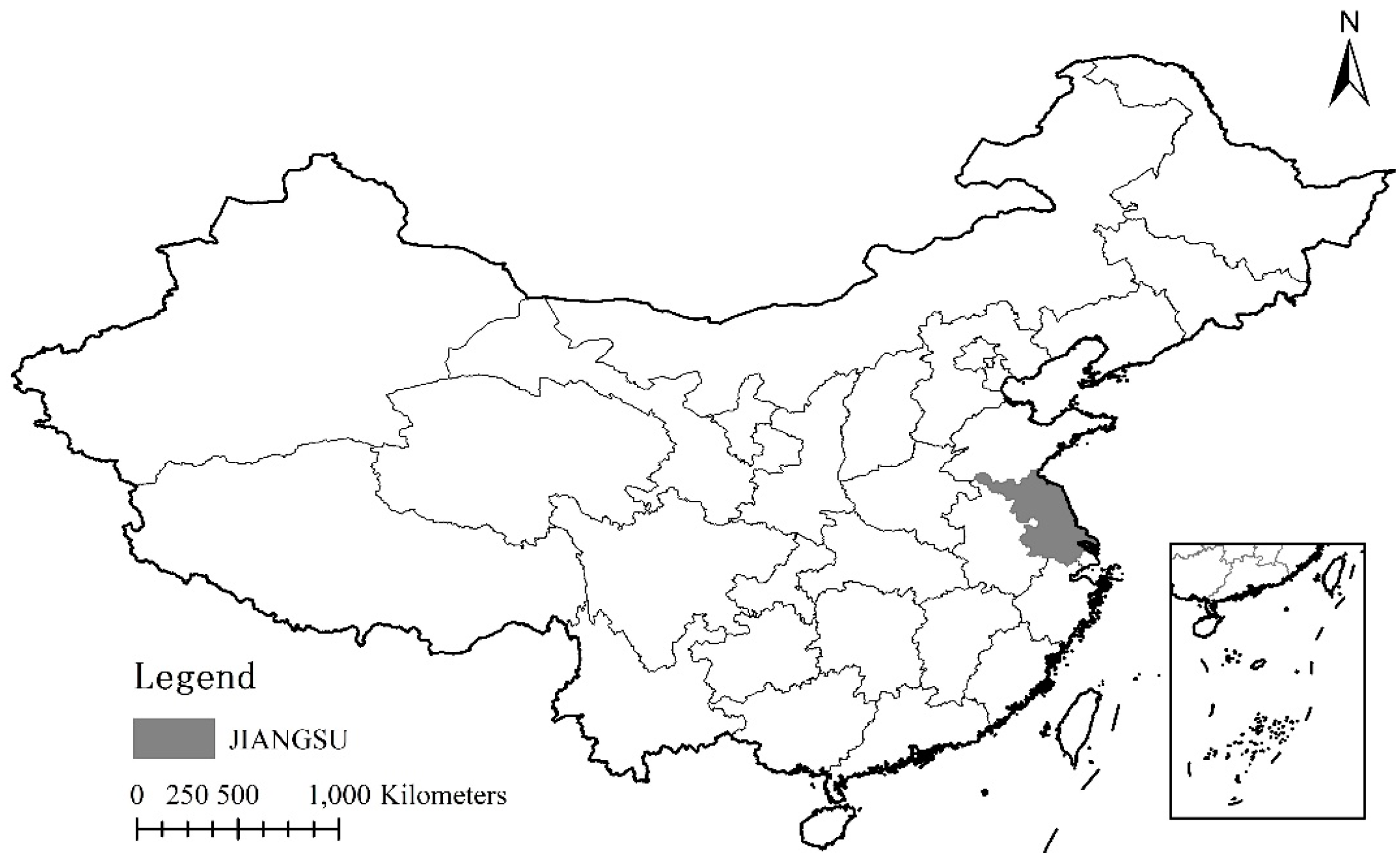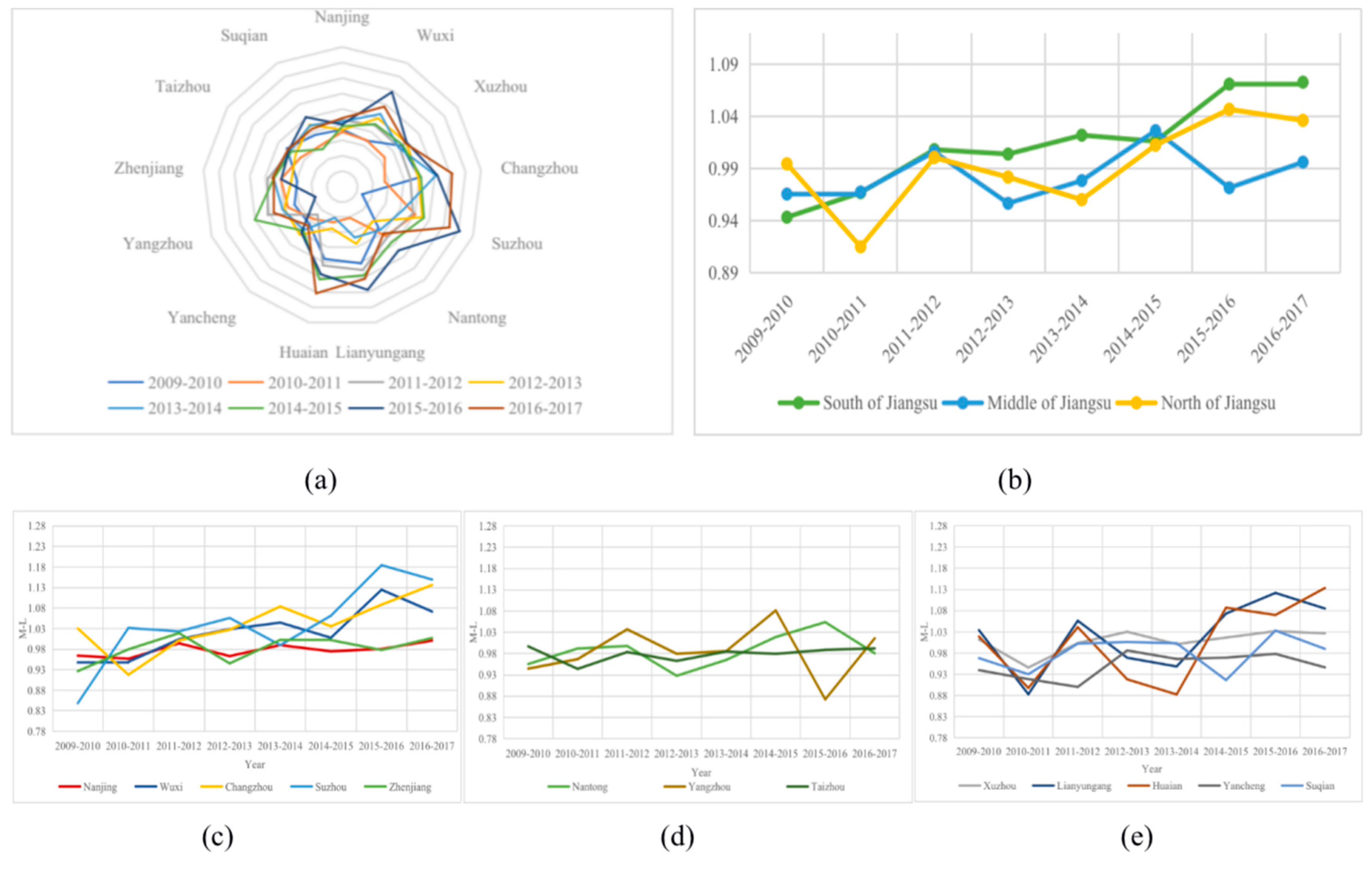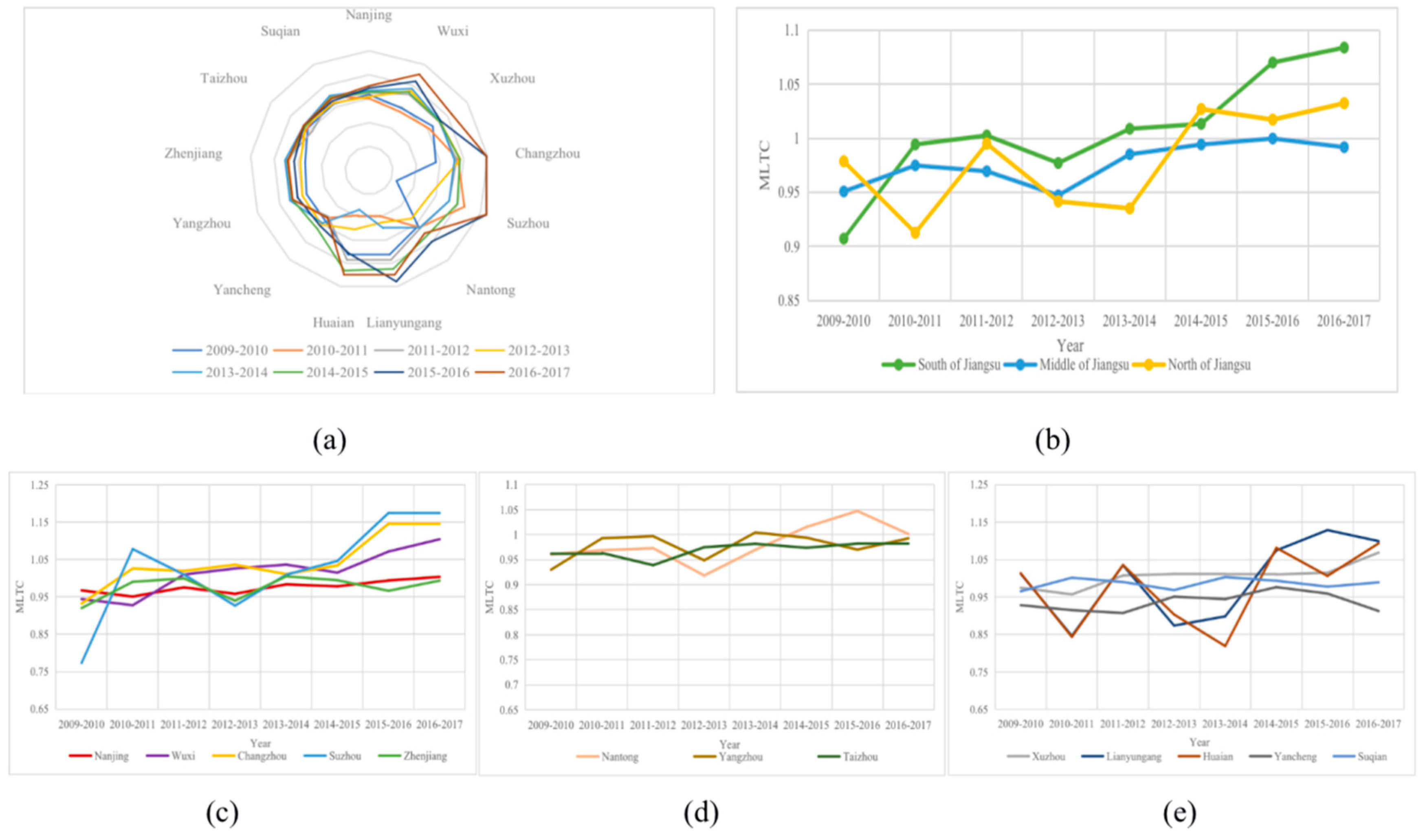Evaluation of Sustainable Urban Development under Environmental Constraints: A Case Study of Jiangsu Province, China
Abstract
:1. Introduction
2. Materials and Methods
2.1. Data
2.2. Methods
3. Analysis
3.1. Indicator Selection
3.2. Results
3.3. Discussion
4. Conclusions
Author Contributions
Funding
Conflicts of Interest
References
- Li, Y.; Yang, W.; Shen, X.; Yuan, G.; Wang, J. Water Environment Management and Performance Evaluation in Central China: A Research Based on Comprehensive Evaluation System. Water 2019, 11, 2472. [Google Scholar] [CrossRef] [Green Version]
- Yang, W.; Li, L. Energy Efficiency, Ownership Structure, and Sustainable Development: Evidence from China. Sustainability 2017, 9, 912. [Google Scholar] [CrossRef] [Green Version]
- Shen, X.; Yang, W.; Sun, S. Analysis of the Impact of China’s Hierarchical Medical System and Online Appointment Diagnosis System on the Sustainable Development of Public Health: A Case Study of Shanghai. Sustainability 2019, 11, 6564. [Google Scholar] [CrossRef] [Green Version]
- Li, L.; Yang, W. Total Factor Efficiency Study on China’s Industrial Coal Input and Wastewater Control with Dual Target Variables. Sustainability 2018, 10, 2121. [Google Scholar] [CrossRef] [Green Version]
- Krugman, P. The myth of Asia’s miracle. Foreign Aff. 1994, 62–78. [Google Scholar] [CrossRef]
- Young, A. The tyranny of numbers: confronting the statistical realities of the East Asian growth experience. Q. J. Econ. 1995, 110, 641–680. [Google Scholar] [CrossRef] [Green Version]
- Young, A. Gold into base metals: Productivity growth in the People’s Republic of China during the reform period. J. Polit. Econ. 2003, 111, 1220–1261. [Google Scholar] [CrossRef] [Green Version]
- Baumgärtner, S.; Quaas, M. What is sustainability economics? Ecol. Econ. 2010, 69, 445–450. [Google Scholar] [CrossRef] [Green Version]
- Westley, F.; Olsson, P.; Folke, C.; Homer-Dixon, T.; Vredenburg, H.; Loorbach, D.; Thompson, J.; Nilsson, M.; Lambin, E.; Sendzimir, J.; et al. Tipping toward sustainability: emerging pathways of transformation. Ambio 2011, 40, 762. [Google Scholar] [CrossRef] [Green Version]
- Shen, L.; Cheng, S.; Gunson, A.J.; Wan, H. Urbanization, sustainability and the utilization of energy and mineral resources in China. Cities 2005, 22, 287–302. [Google Scholar] [CrossRef]
- Zhang, C.; Xu, J. Retesting the causality between energy consumption and GDP in China: Evidence from sectoral and regional analyses using dynamic panel data. Energy Econ. 2012, 34, 1782–1789. [Google Scholar] [CrossRef]
- Sun, X.; Li, J.; Qiao, H.; Zhang, B. Energy implications of China’s regional development: new insights from multi-regional input-output analysis. Appl. Energy 2017, 196, 118–131. [Google Scholar] [CrossRef]
- Wang, Z.; Feng, C.; Zhang, B. An empirical analysis of China’s energy efficiency from both static and dynamic perspectives. Energy 2014, 74, 322–330. [Google Scholar] [CrossRef]
- Li, L.; Hu, J. Ecological total-factor energy efficiency of regions in China. Energy Policy 2012, 46, 216–224. [Google Scholar] [CrossRef]
- Bao, S.; Chang, G.H.; Sachs, J.D.; Woo, W.T. Geographic factors and China’s regional development under market reforms, 1978--1998. China Econ. Rev. 2002, 13, 89–111. [Google Scholar] [CrossRef]
- Jiang, X.; He, X.; Zhang, L.; Qin, H.; Shao, F. Multimodal transportation infrastructure investment and regional economic development: A structural equation modeling empirical analysis in China from 1986 to 2011. Transp. Policy 2017, 54, 43–52. [Google Scholar] [CrossRef]
- Singh, R.K.; Murty, H.R.; Gupta, S.K.; Dikshit, A.K. An overview of sustainability assessment methodologies. Ecol. Indic. 2012, 15, 281–299. [Google Scholar] [CrossRef]
- Pearce, D.; Barbier, E.; Markandya, A. Sustainable Development: Economics and Environment in the Third World; Routledge: London, UK, 2013. [Google Scholar]
- Bateman, I.J.; Mace, G.M.; Fezzi, C.; Atkinson, G.; Turner, K. Economic analysis for ecosystem service assessments. Environ. Resour. Econ. 2011, 48, 177–218. [Google Scholar] [CrossRef] [Green Version]
- Yigitcanlar, T.; Dur, F. Developing a sustainability assessment model: The sustainable infrastructure, land-use, environment and transport model. Sustainability 2010, 2, 321–340. [Google Scholar] [CrossRef] [Green Version]
- Schandl, H.; Hatfield Dodds, S.; Wiedmann, T.; Geschke, A.; Cai, Y.; West, J.; Newth, D.; Baynes, T.; Lenzen, M.; Owen, A. Decoupling global environmental pressure and economic growth: scenarios for energy use, materials use and carbon emissions. J. Clean. Prod. 2016, 132, 45–56. [Google Scholar] [CrossRef]
- Wei, Y.; Huang, C.; Li, J.; Xie, L. An evaluation model for urban carrying capacity: A case study of China’s mega-cities. Habitat Int. 2016, 53, 87–96. [Google Scholar] [CrossRef]
- Yang, W.; Yuan, G.; Han, J. Is China’s air pollution control policy effective? Evidence from Yangtze River Delta cities. J. Clean. Prod. 2019, 220, 110–133. [Google Scholar] [CrossRef]
- Gao, H.; Yang, W.; Yang, Y.; Yuan, G. Analysis of the Air Quality and the Effect of Governance Policies in China’s Pearl River Delta, 2015–2018. Atmosphere 2019, 10, 412. [Google Scholar] [CrossRef] [Green Version]
- Yang, W.X.; Li, L.G. Efficiency evaluation of industrial waste gas control in China: A study based on data envelopment analysis (DEA) model. J. Clean. Prod. 2018, 179, 1–11. [Google Scholar] [CrossRef]
- Yuan, G.; Yang, W. Evaluating China’s Air Pollution Control Policy with Extended AQI Indicator System: Example of the Beijing-Tianjin-Hebei Region. Sustainability 2019, 11, 939. [Google Scholar] [CrossRef] [Green Version]
- Yang, W.X.; Li, L.G. Analysis of Total Factor Efficiency of Water Resource and Energy in China: A Study Based on DEA-SBM Model. Sustainability 2017, 9, 1316. [Google Scholar] [CrossRef] [Green Version]
- Yigitcanlar, T.; Dur, F.; Dizdaroglu, D. Towards prosperous sustainable cities: A multiscalar urban sustainability assessment approach. Habitat Int. 2015, 45, 36–46. [Google Scholar] [CrossRef] [Green Version]
- Shaker, R.R.; Zubalsky, S.L. Examining patterns of sustainability across Europe: a multivariate and spatial assessment of 25 composite indices. Int. J. Sustain. Dev. World Ecol. 2015, 22, 1–13. [Google Scholar] [CrossRef]
- Yang, Q.; Ding, Y.; De Vries, B.; Han, Q.; Ma, H. Assessing regional sustainability using a model of coordinated development index: A case study of mainland China. Sustainability 2014, 6, 9282–9304. [Google Scholar] [CrossRef] [Green Version]
- Yang, B.; Xu, T.; Shi, L. Analysis on sustainable urban development levels and trends in China’s cities. J. Clean. Prod. 2017, 141, 868–880. [Google Scholar] [CrossRef]
- Tan, F.; Lu, Z. Assessing regional sustainable development through an integration of nonlinear principal component analysis and Gram Schmidt orthogonalization. Ecol. Indic. 2016, 63, 71–81. [Google Scholar] [CrossRef]
- Zhang, S. Evaluating the method of total factor productivity growth and analysis of its influencing factors during the economic transitional period in China. J. Clean. Prod. 2015, 107, 438–444. [Google Scholar] [CrossRef]
- Oh, D. A global Malmquist-Luenberger productivity index. J. Product. Anal. 2010, 34, 183–197. [Google Scholar] [CrossRef]
- Oh, D.; Heshmati, A. A sequential Malmquist--Luenberger productivity index: environmentally sensitive productivity growth considering the progressive nature of technology. Energy Econ. 2010, 32, 1345–1355. [Google Scholar] [CrossRef] [Green Version]
- Woo, C.; Chung, Y.; Chun, D.; Seo, H.; Hong, S. The static and dynamic environmental efficiency of renewable energy: A Malmquist index analysis of OECD countries. Renew. Sustain. Energy Rev. 2015, 47, 367–376. [Google Scholar] [CrossRef]
- Kumar, S. Environmentally sensitive productivity growth: a global analysis using Malmquist--Luenberger index. Ecol. Econ. 2006, 56, 280–293. [Google Scholar] [CrossRef]
- Choi, Y.; Oh, D.; Zhang, N. Environmentally sensitive productivity growth and its decompositions in China: a metafrontier Malmquist--Luenberger productivity index approach. Empir. Econ. 2015, 49, 1017–1043. [Google Scholar] [CrossRef]
- Zhang, N.; Choi, Y. Total-factor carbon emission performance of fossil fuel power plants in China: A metafrontier non-radial Malmquist index analysis. Energy Econ. 2013, 40, 549–559. [Google Scholar] [CrossRef]
- National Bureau of Statistics of China. The China Urban Statistical Yearbook, 2010–2018; China Statistics Press: Beijing, China, 2019.
- Bureau of Statistics of Changzhou. Statistical Yearbook of Changzhou, 2010–2018. Available online: http://tjj.changzhou.gov.cn/class/OEJCMFCP (accessed on 28 August 2019).
- Bureau of Statistics of Huai’an. Statistical Yearbook of Huai’an, 2010–2018. Available online: http://tjj.huaian.gov.cn/tjnj/list.html (accessed on 28 August 2019).
- Bureau of Statistics of Xuzhou. Statistical Yearbook of Xuzhou, 2017–2018. Available online: http://tj.xz.gov.cn/TJJ/sjfb/004011/ (accessed on 28 August 2019).
- Bureau of Statistics of Yancheng. Statistical Yearbook of Yancheng, 2015–2018. Available online: http://tjj.yancheng.gov.cn/col/col1779/index.html (accessed on 28 August 2019).
- Bureau of Statistics of Zhenjiang. Statistical Yearbook of Zhenjiang, 2010–2018. Available online: http://tjj.zhenjiang.gov.cn/tjzl/tjnj/ (accessed on 28 August 2019).
- Municipal Government of Suqian. Statistical Yearbook of Suqian, 2010–2017. Available online: http://www.suqian.gov.cn/cnsq/tjnj/list_none.shtml (accessed on 28 August 2019).
- Bureau of Statistics of Lianyungang. Statistical Yearbook of Lianyungang, 2010–2018. Available online: http://tjj.lyg.gov.cn/tjxxw/tjnj/tjnj.html (accessed on 28 August 2019).
- Bureau of Statistics of Nanjing. Statistical Yearbook of Nanjing, 2010–2018. Available online: http://221.226.86.104/file/index.htm (accessed on 28 August 2019).
- Bureau of Statistics of Nantong. Statistical Yearbook of Nantong, 2016–2018. Available online: http://tjj.nantong.gov.cn/ntstj/tjnj/tjnj.html (accessed on 28 August 2019).
- Bureau of Statistics of Suzhou. Statistical Yearbook of Suzhou, 2010–2018. Available online: http://www.sztjj.gov.cn/SztjjGzw/sjtj/003005/ (accessed on 28 August 2019).
- Bureau of Statistics of Taizhou. Statistical Yearbook of Taizhou, 2010–2018. Available online: http://tjj.taizhou.gov.cn/art/2016/6/4/art_2443_591843.html (accessed on 28 August 2019).
- Bureau of Statistics of Wuxi. Statistical Yearbook of Wuxi, 2010–2018. Available online: http://tj.wuxi.gov.cn/ztzl/tjnj/index.shtml (accessed on 28 August 2019).
- China Economic and Social Big Data Research Platform. The Yangtze River Delta City Yearbook, 2010–2014. Available online: http://data.cnki.net/trade/Yearbook/Single/N2013050001?z=Z021 (accessed on 28 August 2019).
- Bureau of Statistics of Jiangsu. Statistical Yearbook of Jiangsu, 2010–2018. Available online: http://tj.jiangsu.gov.cn/col/col4009/index.html (accessed on 28 August 2019).
- The Eco-Environment Bureau of Yangzhou. The Annual Environmental Quality Bulletin of Yangzhou, 2010–2018. Available online: http://hbj.yangzhou.gov.cn/yzhbjceshi/ndhjzlgb/list.shtml (accessed on 28 August 2019).
- The Eco-Environment Bureau of Taizhou. The Annual Environmental Quality Bulletin of Taizhou, 2010–2018. Available online: http://hbj.taizhou.gov.cn/col/col43871/index.html (accessed on 28 August 2019).
- The Eco-Environment Bureau of Suqian. The Annual Information Disclosure Report of Suqian, 2010–2018. Available online: http://www.suqian.gov.cn/cnsq/xxgkml/xxgk_main_mulu.shtml?channel_id=gengduo&webSiteId=a77ae2ccc3e241abb091cc62cb5553de&narrow=false (accessed on 28 August 2019).
- The Eco-Environment Bureau of Lianyungang. The Annual Information Disclosure Report of Lianyungang, 2010–2018. Available online: http://hbj.lyg.gov.cn/xxgknb/xxgknb.html (accessed on 28 August 2019).
- The Eco-Environment Bureau of Huai’an. The Annual Environmental Quality Bulletin of Huai’an, 2010–2018. Available online: http://sthjj.huaian.gov.cn/hjzl/hjgb/list.html (accessed on 28 August 2019).
- Du, J.; Chen, Y.; Huang, Y. A modified Malmquist-luenberger productivity index: Assessing environmental productivity performance in China. Eur. J. Oper. Res. 2018, 269, 171–187. [Google Scholar] [CrossRef]
- Färe, R.; Grosskopf, S.; Margaritis, D. Efficiency and productivity: Malmquist and more. Meas. Product. Effic. Product. growth 2008, 5, 522–622. [Google Scholar]
- Yang, W.; Li, L. Efficiency Evaluation and Policy Analysis of Industrial Wastewater Control in China. Energies 2017, 10, 1201. [Google Scholar] [CrossRef]
- Yuan, G.; Yang, W. Study on optimization of economic dispatching of electric power system based on Hybrid Intelligent Algorithms (PSO and AFSA). Energy 2019, 183, 926–935. [Google Scholar] [CrossRef]
- Yang, Y.; Yang, W. Does Whistleblowing Work for Air Pollution Control in China? A Study Based on Three-party Evolutionary Game Model under Incomplete Information. Available online: https://www.researchgate.net/publication/330315569_Does_Whistleblowing_Work_for_Air_Pollution_Control_in_China_A_Study_Based_on_Three-party_Evolutionary_Game_Model_under_Incomplete_Information (access on 1 January 2020).





| City | M-L Index | |||||||
|---|---|---|---|---|---|---|---|---|
| 2009–2010 | 2010–2011 | 2011–2012 | 2012–2013 | 2013–2014 | 2014–2015 | 2015–2016 | 2016–2017 | |
| South Jiangsu | 0.9434 | 0.9669 | 1.0083 | 1.0040 | 1.0221 | 1.0163 | 1.0711 | 1.0730 |
| Nanjing | 0.9643 | 0.9567 | 0.9943 | 0.9631 | 0.9898 | 0.9747 | 0.9804 | 1.0008 |
| Wuxi | 0.9477 | 0.9491 | 1.0039 | 1.0287 | 1.0446 | 1.0077 | 1.1246 | 1.0715 |
| Changzhou | 1.0303 | 0.9177 | 1.0012 | 1.0271 | 1.0838 | 1.0356 | 1.0882 | 1.1361 |
| Suzhou | 0.8485 | 1.0315 | 1.0232 | 1.0559 | 0.9898 | 1.0613 | 1.1844 | 1.1493 |
| Zhenjiang | 0.9265 | 0.9795 | 1.0190 | 0.9453 | 1.0026 | 1.0020 | 0.9779 | 1.0071 |
| Middle Jiangsu | 0.9656 | 0.9676 | 1.0062 | 0.9568 | 0.9785 | 1.0265 | 0.9717 | 0.9963 |
| Nantong | 0.9554 | 0.9919 | 0.9978 | 0.9278 | 0.9651 | 1.0189 | 1.0538 | 0.9808 |
| Taizhou | 0.9970 | 0.9441 | 0.9836 | 0.9629 | 0.9848 | 0.9794 | 0.9888 | 0.9920 |
| Yangzhou | 0.9445 | 0.9670 | 1.0370 | 0.9796 | 0.9857 | 1.0813 | 0.8724 | 1.0160 |
| North Jiangsu | 0.9947 | 0.9151 | 1.0007 | 0.9820 | 0.9603 | 1.0126 | 1.0469 | 1.0363 |
| Xuzhou | 1.0120 | 0.9460 | 1.0037 | 1.0303 | 1.0011 | 1.0167 | 1.0317 | 1.0266 |
| Lianyungang | 1.0342 | 0.8830 | 1.0563 | 0.9691 | 0.9485 | 1.0732 | 1.1219 | 1.0851 |
| Huaian | 1.0193 | 0.8978 | 1.0411 | 0.9182 | 0.8826 | 1.0872 | 1.0699 | 1.1335 |
| Yancheng | 0.9399 | 0.9187 | 0.9003 | 0.9863 | 0.9662 | 0.9694 | 0.9781 | 0.9464 |
| Suqian | 0.9682 | 0.9302 | 1.0023 | 1.0061 | 1.0033 | 0.9164 | 1.0331 | 0.9901 |
| City | TC Index | |||||||
|---|---|---|---|---|---|---|---|---|
| 2009–2010 | 2010–2011 | 2011–2012 | 2012–2013 | 2013–2014 | 2014–2015 | 2015–2016 | 2016–2017 | |
| South Jiangsu | 0.9073 | 0.9944 | 1.0027 | 0.9772 | 1.0089 | 1.0134 | 1.0702 | 1.0840 |
| Nanjing | 0.9673 | 0.9509 | 0.9754 | 0.9582 | 0.9835 | 0.9781 | 0.9939 | 1.0034 |
| Wuxi | 0.9439 | 0.9277 | 1.0097 | 1.0258 | 1.0361 | 1.0148 | 1.0711 | 1.1039 |
| Changzhou | 0.9322 | 1.0259 | 1.0193 | 1.0360 | 1.0108 | 1.0339 | 1.1455 | 1.1462 |
| Suzhou | 0.7731 | 1.0776 | 1.0097 | 0.9265 | 1.0092 | 1.0458 | 1.1742 | 1.1730 |
| Zhenjiang | 0.9199 | 0.9901 | 0.9994 | 0.9398 | 1.0047 | 0.9945 | 0.9662 | 0.9934 |
| Middle Jiangsu | 0.9509 | 0.9750 | 0.9696 | 0.9473 | 0.9853 | 0.9943 | 0.9999 | 0.9919 |
| Nantong | 0.9607 | 0.9688 | 0.9730 | 0.9184 | 0.9697 | 1.0152 | 1.0473 | 1.0013 |
| Taizhou | 0.9620 | 0.9633 | 0.9390 | 0.9749 | 0.9818 | 0.9738 | 0.9821 | 0.9818 |
| Yangzhou | 0.9300 | 0.9929 | 0.9969 | 0.9487 | 1.0043 | 0.9940 | 0.9701 | 0.9926 |
| North Jiangsu | 0.9788 | 0.9127 | 0.9951 | 0.9417 | 0.9353 | 1.0272 | 1.0174 | 1.0326 |
| Xuzhou | 0.9748 | 0.9570 | 1.0075 | 1.0116 | 1.0112 | 1.0104 | 1.0148 | 1.0685 |
| Lianyungang | 1.0120 | 0.8464 | 1.0349 | 0.8739 | 0.8985 | 1.0744 | 1.1286 | 1.0992 |
| Huaian | 1.0135 | 0.8435 | 1.0356 | 0.9035 | 0.8191 | 1.0812 | 1.0063 | 1.0932 |
| Yancheng | 0.9284 | 0.9150 | 0.9074 | 0.9511 | 0.9445 | 0.9764 | 0.9593 | 0.9128 |
| Suqian | 0.9654 | 1.0016 | 0.9901 | 0.9686 | 1.0033 | 0.9935 | 0.9777 | 0.9891 |
| City | EC Index | |||||||
|---|---|---|---|---|---|---|---|---|
| 2009–2010 | 2010–2011 | 2011–2012 | 2012–2013 | 2013–2014 | 2014–2015 | 2015–2016 | 2016–2017 | |
| South Jiangsu | 0.9925 | 1.0156 | 1.0032 | 1.0023 | 1.0130 | 1.0021 | 0.9945 | 1.0020 |
| Nanjing | 0.9962 | 1.0051 | 1.0193 | 1.0044 | 1.0064 | 0.9962 | 0.9863 | 0.9974 |
| Wuxi | 1.0024 | 1.0217 | 0.9943 | 1.0005 | 1.0072 | 0.9930 | 1.0347 | 0.9650 |
| Changzhou | 1.0343 | 0.9707 | 0.9822 | 0.9907 | 1.0727 | 1.0004 | 0.9433 | 1.0624 |
| Suzhou | 0.9257 | 1.0913 | 1.0005 | 1.0117 | 0.9807 | 1.0132 | 0.9964 | 0.9716 |
| Zhenjiang | 1.0040 | 0.9891 | 1.0194 | 1.0041 | 0.9979 | 1.0076 | 1.0119 | 1.0137 |
| Middle Jiangsu | 1.0110 | 0.9790 | 1.0293 | 0.9888 | 0.9943 | 1.0257 | 1.0071 | 0.9834 |
| Nantong | 0.9933 | 1.0237 | 1.0255 | 0.9483 | 0.9946 | 1.0034 | 1.1174 | 0.9101 |
| Taizhou | 1.0268 | 0.9396 | 1.0225 | 0.9864 | 1.0068 | 0.9860 | 1.0063 | 1.0167 |
| Yangzhou | 1.0129 | 0.9735 | 1.0399 | 1.0318 | 0.9815 | 1.0877 | 0.8976 | 1.0235 |
| North Jiangsu | 1.0150 | 0.9788 | 1.0017 | 1.0081 | 0.9786 | 0.9772 | 1.0063 | 1.0191 |
| Xuzhou | 1.0387 | 0.9860 | 0.9962 | 1.0179 | 0.9900 | 1.0061 | 1.0141 | 0.9595 |
| Lianyungang | 1.0216 | 0.9297 | 1.0107 | 0.9528 | 0.9957 | 0.9960 | 0.9234 | 0.9841 |
| Huaian | 1.0055 | 1.0540 | 1.0036 | 1.0122 | 0.9180 | 1.0023 | 1.0387 | 1.0317 |
| Yancheng | 1.0084 | 0.9966 | 0.9857 | 1.0186 | 0.9895 | 0.9591 | 0.9941 | 1.1191 |
| Suqian | 1.0007 | 0.9276 | 1.0123 | 1.0390 | 1.0000 | 0.9225 | 1.0614 | 1.0010 |
© 2020 by the authors. Licensee MDPI, Basel, Switzerland. This article is an open access article distributed under the terms and conditions of the Creative Commons Attribution (CC BY) license (http://creativecommons.org/licenses/by/4.0/).
Share and Cite
Wang, Y.; Yuan, G.; Yan, Y.; Zhang, X. Evaluation of Sustainable Urban Development under Environmental Constraints: A Case Study of Jiangsu Province, China. Sustainability 2020, 12, 1049. https://doi.org/10.3390/su12031049
Wang Y, Yuan G, Yan Y, Zhang X. Evaluation of Sustainable Urban Development under Environmental Constraints: A Case Study of Jiangsu Province, China. Sustainability. 2020; 12(3):1049. https://doi.org/10.3390/su12031049
Chicago/Turabian StyleWang, Yaqiong, Guanghui Yuan, Ying Yan, and Xueliang Zhang. 2020. "Evaluation of Sustainable Urban Development under Environmental Constraints: A Case Study of Jiangsu Province, China" Sustainability 12, no. 3: 1049. https://doi.org/10.3390/su12031049





